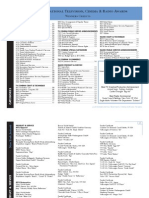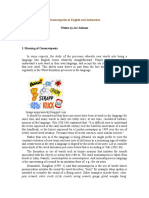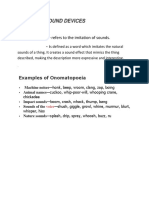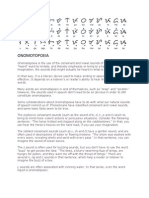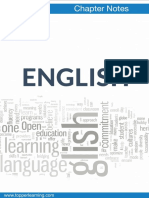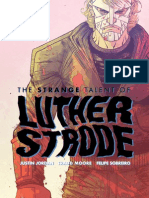Onomatopoeia Press
Onomatopoeia Press
Uploaded by
Victoria ScherbinaCopyright:
Available Formats
Onomatopoeia Press
Onomatopoeia Press
Uploaded by
Victoria ScherbinaCopyright
Available Formats
Share this document
Did you find this document useful?
Is this content inappropriate?
Copyright:
Available Formats
Onomatopoeia Press
Onomatopoeia Press
Uploaded by
Victoria ScherbinaCopyright:
Available Formats
Content
1. Definition of Onomatopoeia 2. Onomatopoeia and its derivatives 3. Uses of onomatopoeia 4. Comics and advertising 5. Onomatopoeia in jokes 6. Onomatopoeia poems
An onomatopoeia from the "name" and "I make" is a word that imitates or suggests the source of the sound that it describes. Onomatopoeia refers to the property of such words. Common occurrences of onomatopoeias include animal noises, such as "oink" or "meow" or "roar". Onomatopoeias are not the same across all languages; they conform to some extent to the broader linguistic system they are part of; hence the sound of a clock may be tick tock in English, d d in Mandarin, or katchin katchin in Japanese. Definition of Onomatopoeia Onomatopoeia is the formation of a word from a sound associated with what is named (e.g., cuckoo, sizzle). However the word Onomatopoeia can also be used to describe the use of such words for rhetorical effect. For example, in the sentence 'The poet Tennyson used onomatopoeia as a linguistic device' (see example below). Onomatopoeia and its derivatives The adjective onomatopoeic can be used in the sentence 'Woof is an example of onomatopoeia'.
The adverb onomatopoeically is used in the sentence 'She lived her life onomatopoeically ...whoopy!' Uses of onomatopoeia In the case of a frog croaking, the spelling may vary because different frog species around the world make different sounds: Ancient Greek brekekekex koax koax (only in Aristophanes' comic play The Frogs) for probably marsh frogs; English ribbit for species of frog found in North America; English verb "croak" for the common frog. Related to this is the use of tibbir for the toad. Some other very common English-language examples include hiccup, zoom, bang, beep, and splash. Machines and their sounds are also often described with onomatopoeia, as in honk or beep-beep for the horn of an automobile, and vroom or brum for the engine. When someone speaks of a mishap involving an audible arcing of electricity, the word "zap" is often used (and has subsequently been expanded and
used to describe non-auditory effects generally connoting the same sort of localized but thorough interference or destruction similar to that produced in short-circuit sparking). For animal sounds, words like quack (duck), moo (cow), bark or woof (dog), roar (lion), meow or purr (cat) and baa (sheep) are typically used in English. Some of these words are used both as nouns and as verbs. Agglutinative languages or synthetic languages flexibly integrate onomatopoeic words into their structure. This may evolve into a new word, up to the point that it is no longer recognized as onomatopoeia. One example is English "bleat" for the sheep noise: in medieval times it was pronounced approximately as "blairt" (but without an Rcomponent), or "blet" with the vowel drawled, which is much more accurate as onomatopoeia than the modern pronunciation. An example of the opposite case is "cuckoo", which, due to continuous familiarity with the bird noise down the centuries, has kept approximately the same pronunciation as in Anglo-Saxon times and its vowels have not changed to as in "furrow". Verba dicendi are a method of integrating onomatopoeia and ideophones into grammar. Sometimes things are named from the sounds they make. In English, for example, there is the universal fastener which is named for the onomatopoeic of the sound it makes: the zip (in the UK) or zipper (in the U.S.). Many birds are named after their calls, such as the Bobwhite quail, the Weero, the Morepork, the killdeer, chickadee, the cuckoo, the chiffchaff, the whooping crane and the whip-poor-will. In Tamil and Malayalam, the word for crow is kaakaa. This practice is especially common in certain languages such as Mori and, therefore, in names of animals borrowed from these languages. Comics and advertising Comic strips and comic books made extensive use of onomatopoeia. Popular culture historian Tim DeForest noted the impact of writer-artist Roy Crane (19011977), the creator of Captain Easy and Buz Sawyer:
It was Crane who pioneered the use of onomatopoeic sound effects in comics, adding "bam," "pow" and "wham" to what had previously been an almost entirely visual vocabulary. Crane had fun with this, tossing in an occasional "ker-splash" or "licketywop" along with what would become the more standard effects. Words as well as images became vehicles for carrying along his increasingly fast-paced storylines.[4] In 2002, DC Comics introduced a villain named Onomatopoeia, an athlete, martial artist and weapons expert who often speaks sounds. Advertising uses onomatopoeia as a mnemonic, so consumers will remember their products, as in Alka-Seltzer's "Plop, plop, fizz, fizz. Oh, what a relief it is!" jingle, recorded in two different versions (big band and rock) by Sammy Davis, Jr. Rice Krispies (US and UK) and Rice Bubbles (AU) make a "snap, crackle, pop" when one pours on milk. During the 1930s, the illustrator Vernon Grant developed Snap, Crackle and Pop as gnome-like mascots for the Kellogg Company. Sounds surface in road safety advertisements: "clunk click, every trip" (click the seatbelt on after clunking the car door closed; UK campaign) or "click, clack, front and back" (click, clack of connecting the seatbelts; AU campaign) or "click it or ticket" (click of the connecting seatbelt; US DOT campaign). Manner imitation In many of the world's languages, onomatopoeia-like words are used to describe phenomena apart from the purely auditive. Japanese often utilizes such words to describe feelings or figurative expressions about objects or concepts. For instance, Japanese barabara is used to reflect an object's state of disarray or separation, and shiiin is the onomatopoetic form of absolute silence (used at the time an English speaker might expect to hear the sound of crickets chirping or a pin dropping in a silent room, or someone coughing). It is used in English as well with terms like bling, which describes the glinting of light on things like gold, chrome or precious stones. In Japanese, kirakira is used for glittery things.
Onomatopoeia in jokes Onomatopoeia can be used as a linguistic device in many types of writings including jokes. Do you remember the old Knock-Knock jokes, even the name of this type of joke is another example of onomatopoeia. What about the joke: Knock-knock Who's there? Boo Boo who? Don't cry, I was only joking
Onomatopoeia poems Onomatopoeia is also used by poets to convey their subject to the reader. For example, in the last lines of Sir Alfred Tennyson's poem 'Come Down, O Maid', m and n sounds produce an atmosphere of murmuring insects:
... the moan of doves in immemorial elms, And murmuring of innumerable bees.
Examples of onomatopoeia are also commonly found in poems and nursery rhymes written for children. Onomatopoeic words produce strong images that can both delight and amuse kids when listening to their parents read poetry. Some examples of onomatopoeia poems for children are: Baa Baa Black Sheep Old Macdonald
Both of these poems use onomatopoeic representations of animal noises to entertain. There are many other examples of onomatopoeia found in kid's poetry, see if you can hear them next time you listen to a nursery rhyme.
Animals Alligators Apes Ass Badgers Bear Bee Bird Bull Cat Calve Chick Cock Cow Coyote Cuckoo Dingo Dinosaur Dog Dolphin Donkey Doves Eagles Elephant Falcon Ferret Fish Flies Fox Frog Geese Giraffe goat Hare
Sounds hiss, grunt gibber bray growl growl buzz chirrup, chirp, tweet bellow meow, mew, purr bleat peep crow moo, low yelp, cry cuckoo bark, cry grr, growl, screech bark, bow wow, woof click eeh aah, heehaw coo scream trumpet chant dook glub, blub, glug buzz yelp, bark croak cackle, hiss, honk, quack bleat bleat squeak
Horse Hyena Jackal Jay Lion Magpie Mice Monkey Moose Mosquitoes Ostrich Owl Parrot Peacocks Penguin Pig Raccoon Raven Rook Stag Swallow Turkey Vulture Walrus Whale Wolf Zebra
whinny laugh howl chatter roar chatter squeak gibber bellow whine bleep screech talk scream honk oink chitter croak caw bellow twit and squeal gobble scream groan sings howl, cry click
Grasshopper chirp
List of used literature
1. Crystal, David (1997). The Cambridge Encyclopedia of Language (2nd ed.). Cambridge University Press. ISBN 0-521-55967-7. 2. Smyth, Herbert Weir (1920). Greek Grammar. Cambridge MA: Harvard University Press. p. 680. ISBN 0-674-36250-0. 3. Tutorial on Drawing Onomatopoeia for Comics and Cartoons (using fonts) 4. WrittenSound, onomatopoeic word list 5. Examples of Onomatopeia
You might also like
- Beowulf The Graphic Novel-1Document66 pagesBeowulf The Graphic Novel-1Korey Bradley63% (8)
- Linguistic Stylistics - Gabriela Missikova part3 (публиц)Document36 pagesLinguistic Stylistics - Gabriela Missikova part3 (публиц)Romana ZápotockáNo ratings yet
- Edgar Allan Poe's The Raven For English Learners PDFDocument106 pagesEdgar Allan Poe's The Raven For English Learners PDFMiuu ag100% (1)
- Characterization NotesDocument2 pagesCharacterization Notesapi-267238285No ratings yet
- 2006 International Television, Cinema & Radio Awards: Winners CreditsDocument17 pages2006 International Television, Cinema & Radio Awards: Winners CreditsaptureincNo ratings yet
- Judge Dredd Classics, Vol. 1: Apocalypse War PreviewDocument12 pagesJudge Dredd Classics, Vol. 1: Apocalypse War PreviewGraphic Policy75% (4)
- Comedy WrittingDocument40 pagesComedy WrittingNathaniel Murry100% (4)
- 2d Animation Research Report by James CartwrightDocument3 pages2d Animation Research Report by James Cartwrightapi-239345047No ratings yet
- Onomatopoeia: Name: Livia Jeanne Saputra NIM: 20170600024Document11 pagesOnomatopoeia: Name: Livia Jeanne Saputra NIM: 20170600024Anak Muda GroupNo ratings yet
- All Onomatopoeia Words Are Underlined and Written in ItalicDocument48 pagesAll Onomatopoeia Words Are Underlined and Written in Italicom prakashNo ratings yet
- Factual Wisdom for the Age of Apostasy: A Book of Ruminations, Aphorisms, Sayings and Proverbs in Reference to the Issues of Life Associated with the Five Areas of Being HumanFrom EverandFactual Wisdom for the Age of Apostasy: A Book of Ruminations, Aphorisms, Sayings and Proverbs in Reference to the Issues of Life Associated with the Five Areas of Being HumanNo ratings yet
- World LiteratureDocument21 pagesWorld LiteratureRyan ReyesNo ratings yet
- Onomatopoeia ExamplesDocument6 pagesOnomatopoeia ExamplesAnonymous lKxkZ9MNo ratings yet
- Brilliant Ideas by Brilliant Minds Masood ThahimDocument250 pagesBrilliant Ideas by Brilliant Minds Masood ThahimAwais PanhwarNo ratings yet
- OnomatopoeiaDocument7 pagesOnomatopoeiabalweg mackyNo ratings yet
- Onomatopoeia: PhoneticallyDocument6 pagesOnomatopoeia: PhoneticallyVanessa Paula ReyesNo ratings yet
- OnomatopeyaDocument6 pagesOnomatopeyaRosaura PerezNo ratings yet
- Onomatopoeia in English and IndonesianDocument7 pagesOnomatopoeia in English and IndonesianArtaria NurainiNo ratings yet
- 5 Literary Devices of OnomatopoeiaDocument2 pages5 Literary Devices of OnomatopoeiaJema Rose VelascoNo ratings yet
- What Is An OnomatopoeiaDocument6 pagesWhat Is An OnomatopoeiawysacadNo ratings yet
- 11 OnomatopoeiaDocument11 pages11 OnomatopoeiaEsatEccoGicićNo ratings yet
- Various Literary Devices 21st Century Literature From The Philippines and The World Sound DevicesDocument3 pagesVarious Literary Devices 21st Century Literature From The Philippines and The World Sound DevicesKarla Bernadette LugtuHonrado GonzalesNo ratings yet
- Acronym Report 1st YearDocument12 pagesAcronym Report 1st YearMatin-ao, Aileen P.No ratings yet
- Words That Go Ping Chapter SamplerDocument19 pagesWords That Go Ping Chapter SamplerAllen & UnwinNo ratings yet
- PunDocument7 pagesPunMarto FeNo ratings yet
- Handouts Session2Document13 pagesHandouts Session2Евгения ХвостенкоNo ratings yet
- Video-Lecture 3 Phonological and Graphical Expressive MeansDocument4 pagesVideo-Lecture 3 Phonological and Graphical Expressive Meansалександра КудряшоваNo ratings yet
- Jumong EnglishDocument46 pagesJumong EnglishkayeNo ratings yet
- Explosion OnomatopoeiaDocument2 pagesExplosion OnomatopoeianidharshanNo ratings yet
- Alphabet Juice: The Energies, Gists, and Spirits of Letters, Words, and Combinations Thereof; Their Roots, Bones, Innards, Piths, Pips, and Secret Parts, Tinctures, Tonics, and Essences; With Examples of Their Usage Foul and SavoryFrom EverandAlphabet Juice: The Energies, Gists, and Spirits of Letters, Words, and Combinations Thereof; Their Roots, Bones, Innards, Piths, Pips, and Secret Parts, Tinctures, Tonics, and Essences; With Examples of Their Usage Foul and SavoryRating: 3.5 out of 5 stars3.5/5 (89)
- Figure of Speech ExamplesDocument3 pagesFigure of Speech ExamplesClumsyHumaneNo ratings yet
- 6 AlliterationDocument27 pages6 Alliteration昊 皮No ratings yet
- Water Onomatopoeia ExamplesDocument8 pagesWater Onomatopoeia ExamplesCristina Maria NistorNo ratings yet
- Figures of Speech and Literary Devices 1. SimileDocument10 pagesFigures of Speech and Literary Devices 1. SimileBeena VargheseNo ratings yet
- OnomatopoeiaDocument4 pagesOnomatopoeiaJacob BoldwinNo ratings yet
- Phonics RulesDocument18 pagesPhonics RulesAisy Astarina100% (1)
- Stylistic PhoneticsDocument37 pagesStylistic PhoneticsДжинси МілаNo ratings yet
- Figure of Speech: Onomatopoeia Hyperbole Synecdoche AlliterationDocument29 pagesFigure of Speech: Onomatopoeia Hyperbole Synecdoche AlliterationElaine PolicarpioNo ratings yet
- Examples of AssonanceDocument4 pagesExamples of AssonanceGGiovanni AbrigoNo ratings yet
- Onomatopoeia DefinitionDocument3 pagesOnomatopoeia DefinitionAnggelia Natalsya EmorNo ratings yet
- PUNDocument56 pagesPUNAdibah ZulkefliNo ratings yet
- Гуцал Аліна, Івчук Ілона, Мамотюк Світлана, Ткачук АлісаDocument35 pagesГуцал Аліна, Івчук Ілона, Мамотюк Світлана, Ткачук АлісаАлісочка ТкачукNo ratings yet
- Alliteration, Assonance, Onomatopoiea, IronyDocument43 pagesAlliteration, Assonance, Onomatopoiea, IronydinejedidahNo ratings yet
- The Lost Words: A Feast of Forgotten Words, Their Origins and Their MeaningsFrom EverandThe Lost Words: A Feast of Forgotten Words, Their Origins and Their MeaningsNo ratings yet
- Phonetic Stylistic DevicesDocument5 pagesPhonetic Stylistic DevicesMasha YashchukNo ratings yet
- Onomotopoeia: L Sounds Are Often Associated With Running Water. in That Sense, Even The WordDocument6 pagesOnomotopoeia: L Sounds Are Often Associated With Running Water. in That Sense, Even The WordJoanna Erika S. OsiasNo ratings yet
- What Is OnomatopoeiaDocument8 pagesWhat Is OnomatopoeiaFritzie Andrea TirolNo ratings yet
- Figures of SpeechDocument6 pagesFigures of SpeechJoshua CondezaNo ratings yet
- Figurative LanguageDocument32 pagesFigurative LanguageMichelle Lee100% (1)
- Phonetics and Phonology612Document56 pagesPhonetics and Phonology612carlosdrosarioNo ratings yet
- Assonance Alliteration Consonance DDDDDDocument3 pagesAssonance Alliteration Consonance DDDDDCarl Andrey Espinosa100% (1)
- MyPDF MyPDF 20211205imprimirDocument42 pagesMyPDF MyPDF 20211205imprimirromeroflaviax01No ratings yet
- A Song of Ice and Fire Game of ThronesDocument3 pagesA Song of Ice and Fire Game of Thronesdirty sausageNo ratings yet
- Oxymorons Onomatopoeias and HyperbolesDocument4 pagesOxymorons Onomatopoeias and Hyperbolesapi-203814269No ratings yet
- Phonetic Expressive Means...Document6 pagesPhonetic Expressive Means...badalyan.nairuhiNo ratings yet
- Figures of Speech in EnglishDocument20 pagesFigures of Speech in EnglishRavi KumarNo ratings yet
- W13. CoinageDocument15 pagesW13. CoinageThảo TrầnNo ratings yet
- Final Figures of SpeechDocument135 pagesFinal Figures of SpeechChristine D. GonzalesNo ratings yet
- Pronunciation RulesDocument5 pagesPronunciation Rulesjohnnorton.academyNo ratings yet
- Figures of SpeechDocument2 pagesFigures of SpeechJOEN SANTOS SEVILLANo ratings yet
- ContinueDocument3 pagesContinueBonsa AdugnaNo ratings yet
- Word Forming Proccess CoinageDocument2 pagesWord Forming Proccess CoinageCarlos Eduardo Rosado TorresNo ratings yet
- Biology Wksheet 1Document4 pagesBiology Wksheet 1GopalNo ratings yet
- Assignment I - Cartoon Network - Case Study - 4th SepDocument8 pagesAssignment I - Cartoon Network - Case Study - 4th Sepshreya chapagainNo ratings yet
- Document16 1st13rdDocument6,223 pagesDocument16 1st13rdPcnhs SalNo ratings yet
- A Brief History of ComicsDocument5 pagesA Brief History of ComicsSienna MaddenNo ratings yet
- Instant Download Classics and Comics 1st Edition George Kovacs PDF All ChapterDocument84 pagesInstant Download Classics and Comics 1st Edition George Kovacs PDF All Chaptermendeishanek100% (3)
- LEGO Club Magazine Red Brick MarchpdfDocument47 pagesLEGO Club Magazine Red Brick Marchpdfmartayensid96% (28)
- Parts of The BookDocument5 pagesParts of The BooklidianaNo ratings yet
- Chess, Comic Strips, and Cartoons: by Bill WallDocument55 pagesChess, Comic Strips, and Cartoons: by Bill WallKartik ShroffNo ratings yet
- To Kill A Mocking Bird - VocabularyDocument0 pagesTo Kill A Mocking Bird - VocabularyMihai Adrian100% (2)
- Kelompok Review Text Middle TestDocument6 pagesKelompok Review Text Middle TestZulfaNurainiNo ratings yet
- COMICSDocument2 pagesCOMICSCarrie BotwinNo ratings yet
- RT Lamour: Edited by Jim Amash and Eric Nolen-WeathingtonDocument38 pagesRT Lamour: Edited by Jim Amash and Eric Nolen-WeathingtonSérgio Godinho100% (1)
- Annimation DingleDocument60 pagesAnnimation DingleprimummobileNo ratings yet
- Vampirella 021 1972Document76 pagesVampirella 021 1972MindSpaceApocalypse86% (7)
- Artist Research - William Heath RobinsonDocument15 pagesArtist Research - William Heath RobinsonGarisson ImpalaNo ratings yet
- The Strange Talent of Luther Strode Exclusive PreviewDocument7 pagesThe Strange Talent of Luther Strode Exclusive PreviewUSA TODAY ComicsNo ratings yet
- Tom and JerryDocument30 pagesTom and JerryAsim Iftikhar100% (1)
- A Critical Analysis: Scott Pilgrim vs. The World: Singh 1Document3 pagesA Critical Analysis: Scott Pilgrim vs. The World: Singh 1Jayvee MoralesNo ratings yet
- Kid Legends SamplerDocument113 pagesKid Legends SamplerQuirk BooksNo ratings yet
- Reading Bart SimpsonDocument1 pageReading Bart SimpsonVirginia SaintpaulNo ratings yet
- Life, Art, Words, by Boel Westin Sculptor's Daughter - by Tove JanssonDocument3 pagesLife, Art, Words, by Boel Westin Sculptor's Daughter - by Tove Janssonalex647No ratings yet
- Rubric Use To Evaluate Comic StripDocument2 pagesRubric Use To Evaluate Comic Stripjose fadrilanNo ratings yet
- Willy Wonka Drawing Cartoon Boat - Google SearchDocument1 pageWilly Wonka Drawing Cartoon Boat - Google Searchvwb75smj9dNo ratings yet
- Maths Project 1Document5 pagesMaths Project 1Abhi KrickNo ratings yet
- DisneyDocument1 pageDisneyLucijaNo ratings yet




